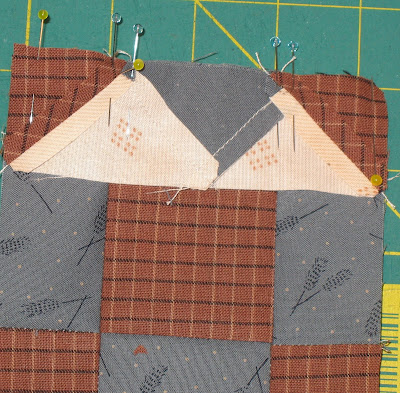What are Half Square Triangles (HST)? Really, they are two triangles sewn together that make a square. Each triangle has a Right angle (90 degrees) that makes up one corner of the square. Two right angles, two corners. The other two corners are composed of triangle tips that are sewn together to make a right angle.
Most of the HSTs we sew will be anywhere from ½” finished to 3” finished size. That does not include the seam allowance!
How many ways are there to make half square triangles? Several, maybe even lots. Let’s look at a few.
1. To make two HST: Cut a square of each color 7/8” larger than the finished size, cut in half diagonally, put color 1 triangle right sides together with color 2 triangle, sew ¼” seam on long edge. Press.
Con – cutting diagonally sometimes doesn’t get exactly from tip to tip, making triangles not the precise size
Con – sewing on bias edge can stretch
Con – that pressing part, I generally get it skewed, ways to not do this, finger press open, then just put iron down on seam, don’t move it around. Or, press with the grainline (works better on larger triangles)
2. Almost like #1: Cut a square of each color 7/8” larger than the finished size. On the lighter fabric draw diagonal lines ¼” away from center diagonal (only one of them!); put right sides together, stitch on drawn lines (or right next to them inside the seam allowance); cut between stitching; Press
Pro – stitching before cutting minimizes cutting errors and bias stretching
Con – the pressing part
3. Almost like #2: Cut a square of each color 1” larger than the finished size. On the lighter fabric draw diagonal lines ¼” away from center diagonal (only one of them!); put right sides together, stitch on drawn lines; cut between stitching; Press; Use small square ruler with diagonal to trim to appropriate unfinished size
Pro – stitching before cutting minimizes cutting errors and bias stretching
Pro – trimming after pressing gets you a perfect HST
Con – more steps
4. If making a lot of HSTs using the same fabric, use either Marsha McCloskey’s method or Debbie Caffrey’s method (same as Sharon Schamber’s method)
Cut a large square of each fabric. Cut Diagonal strips. Alternate strips, sew together on bias edges (slightly different for each method). Cut out HST the correct unfinished size.
Pro – you get perfect HSTs
Con – works best if you need lots of the same HSTs
5. Use templates, and again here there are a few ways.
5a. Marti Michell templates – several sizes are available down to 1” finished triangles, generally in ½” increments, great for machine piecing, not so much for hand (if you need a seam line). Use Invisi-grip to keep template from slipping.
1” – N80 or D29 (also in Just half square triangles)
1.5” – A6
1.75” – E35
2” – B13 (also in Just half square triangles)
2.5” – Q94, E
3” – A1 (also in Just half square triangles)
3.5” – E32
4” – B9 (also in Just half square triangles)
5” – in Just half square triangles
5b. Paper templates – I put a 1/16” hole using a paper punch at the corners (seamline intersections) when hand piecing, don’t really need it for machine
Put DST (double sided tape) on the wrong side of the template (keeps it from slipping). Using your rotary cutter, place ¼” on the seam line and cut out shape. I try to add the special MM template corners when doing this, makes it easier to line things up. EQ corners are similar. This method is useful for those 5-patch blocks you don't want to paper piece.
5c. Template plastic templates - I put a 1/16” hole using a paper punch at the corners (seam line intersections). Mark the fabric through the holes, draw between the dots. Using your rotary cutter, place ¼” on the seam line and cut out shape. The drawn seam line is great when hand piecing, but also machine piecing, especially when doing Y seams (not that we are with HSTs )
After your pieces are cut, if necessary trim the points. This is taking off the extra 3/8” tip at the skinny corners. It makes it easier to line things up when sewing, and your tips don’t get sucked into your sewing machine. There are various tools for this. Use any MM triangle template. Fons and Porter makes one, as do others. You can also use your regular rotary cutting ruler, cut a line perpendicular to the diagonal, ¼” away from the seam intersection (this is when those dots can be handy).
Pin close to the end of the diagonal. You can use this to guide the triangle, and keeps the ends lined up. Use a skinny pin to minimize distortion.
Sew the diagonal seam. Use an awl, long pin, or seam ripper to smooch the upper fabric towards the needle if you don’t have an even feed built into your machine. Remove the pin just as you get to it, keep the awl point on the triangles to keep them in place, remove pin, keep sewing to end with awl holding the fabric to maintain your ¼” seam all the way.
Set your seam with the iron, finger press open, then press with iron, being careful not to distort your HST. Measure it and see how good you got. If it is just a little wonky you can generally pull it into place.






































